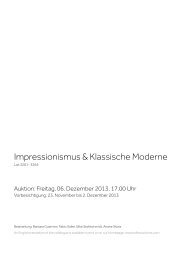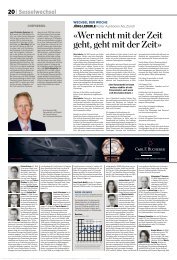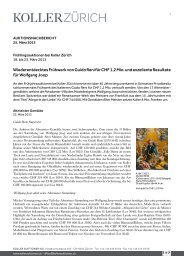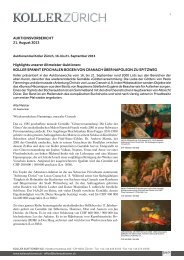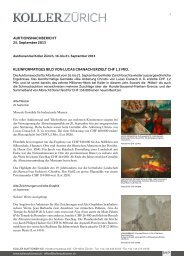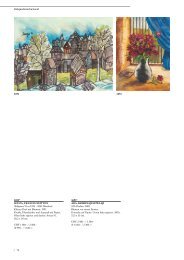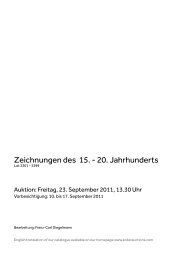PDF Katalog - Koller Auktionen
PDF Katalog - Koller Auktionen
PDF Katalog - Koller Auktionen
Erfolgreiche ePaper selbst erstellen
Machen Sie aus Ihren PDF Publikationen ein blätterbares Flipbook mit unserer einzigartigen Google optimierten e-Paper Software.
3030<br />
FRANCK, PAUWELS<br />
called PAOLO FIAMMINGO<br />
(Antwerp c. 1540 - 1596 Venice)<br />
Assembly of the Gods: The Loves of the Gods.<br />
c. 1585. Oil on canvas.<br />
119.6 x 166.7 cm.<br />
Provenance: Swiss Private Collection since circa<br />
1980.<br />
Certificate: Dr. Andrew John Martin, 5.12. 2001.<br />
Literature:<br />
- Martin, Andrew John: Erdzeitalter, nicht der<br />
„Frühling“. Hans Fugger und die Zyklen Paolo<br />
Fiammingos, in: Johannes Burkhardt and Franz<br />
Karg (eds.): Die Welt des Hans Fugger (1531-<br />
1598), Material zur Geschichte der Fugger,<br />
Augsburg 2007, i, p. 203, fig. 8.<br />
Further Reading:<br />
- Lill, Georg: Hans Fugger (1531-1598) und die<br />
Kunst. Ein Beitrag zur Geschichte der<br />
Spätrenaissance in Süddeutschland, (Studien<br />
zur Fuggergeschichte, 2), Leipzig 1908, pp.<br />
138-147, esp. p. 147.<br />
- Meijer, Bert W.: Paolo Fiammingo reconside<br />
red, in: Mededelingen van het Nederlands<br />
Instituut te Rome 37, 1975, pp. 117-130, there<br />
p. 121f. and Pl. 36.<br />
- Mason Rinaldi, Stefania:, Paolo Fiammingo,<br />
in: Saggi e memorie dell’arte 11, 1978, pp.<br />
46-188, there pp. 60f. and 70. -Meijer, Bert<br />
W.: Paolo Fiammingo tra indigeni e ‘forestieri’<br />
a Venezia, in: Prospettiva 32, 1983, pp. 21-32,<br />
there p. 27, fig. 19.<br />
- Lutz, Georg: Gegenreformation und Kunst in<br />
Schwaben und in Oberitalien: der Bilderzyklus<br />
des Vincenzo Campi im Fuggerschloss<br />
Kirchheim, in: Bernd Roeck, Klaus Bergdolt<br />
and Andrew John Martin (eds.), Venedig und<br />
Oberdeutschland in der Renaissance.<br />
Beziehungen zwischen Kunst und Wirtschaft<br />
(Studi. Schriftenreihe des Deutschen<br />
Studienzentrums in Venedig, 9), Sigmaringen<br />
1993, pp. 131-154, there p. 139f. and fig. 6.<br />
- Martin, Andrew John: Quellen zum<br />
Kunsthandel um 1550-1600. Die Firma Ott in<br />
Venedig, in: Kunstchronik 48, 1995, 11, pp.<br />
535-539.<br />
- Martin, Andrew John: Jacopo Tintoretto:<br />
dipinti per committenti tedeschi, in: Paola<br />
Rossi and Linello Puppi (eds.), Jacopo<br />
Tinroretto nel quarto centenario della morte.<br />
Atti del convegno internazionale di studi,<br />
Kongress Venedig, November 1994 (Quaderni<br />
di Venezia Arti, 3), Padua 1996, pp. 97-100<br />
and 309-311, there p. 99.<br />
- Martin, Andrew John: Augsburg, Prague and<br />
Venice at the End of the Century, in:<br />
Bernhard Aikema and Beverly Louise Brown<br />
(eds.), Renaissance Venice and the North.<br />
Crosscurrents in the Time of Bellini, Dürer<br />
and Titian (Il Rinascimento a Venezia e la pit<br />
tura del Nord ai tempi di Bellini, Dürer,<br />
Tiziano), exh. cat. Palazzo Grassi, Venice<br />
1999/2000, two English editions; 1st and 2nd<br />
revised Italian editions, Milan/London 1999,<br />
pp. 614-659, there pp. 618-621, 630-631, 652-<br />
653 and 656-657.<br />
Abb. 2. Paolo Fiammingo, Das Goldene Zeitalter.<br />
Pauwels Franck, born around 1540 in Antwerp,<br />
moved to Venice in 1573, where he was known<br />
under the italianate name Paolo Fiammingo, after<br />
his native Flanders, and he remained there until<br />
his death in 1596. He received his artistic training<br />
in Antwerp and was recorded in the local<br />
painters’ Guild of St. Luke as a master in 1561.<br />
He specialised in landscapes and still lifes in<br />
Venice and was active first in the workshop of<br />
Jacopo Tintoretto (1519-1594), before establishing<br />
his own studio (see the life and work under<br />
Further Reading: Mason Rinaldi, 1978, pp.<br />
46-188). His painting style is informed in large<br />
part by Titian, Veronese and Tintoretto; so that<br />
he can be described less as a Flemish, more as a<br />
Venetian master. The painting of museum quality<br />
offered here, recently discovered in a Swiss<br />
private collection, illustrates in a splendid style<br />
Paolo Fiammingo’s artistic strengths. Though the<br />
painting was seen as a work by Titian, Dr.<br />
Andrew J. Martin confirms positively that this is<br />
a characteristic work by Paolo Fiammingo. An<br />
assembly of the gods with Jupiter, Vulcan,<br />
Neptune, Venus and Cupid representing the<br />
loves of the gods, is depicted before a wide river<br />
landscape. At the left edge of the picture is a<br />
nude couple and five more pairs, proportionately<br />
smaller, are placed within the scene. The last five<br />
groups came to light recently after a careful cleaning<br />
of the picture, which had been painted over<br />
by a previous owner with different moral convictions.<br />
Even the nude Venus at the right edge of<br />
the picture later received a cloth covering around<br />
her hips (see fig. 1). In the foreground is the<br />
imposing figure of Neptune, who acts as a<br />
repoussoir device, turning his muscular back to<br />
the viewer and drawing them into the scene with<br />
his gaze. At the same time, the dolphin confronts<br />
the viewer with its large eyes and captures their<br />
attention. Aside from the imposing monumentality<br />
of the figures in the foreground, the landscape<br />
in the background is distinguished by great virtuosity<br />
and variety. Thus the hilly landscape in the<br />
right half of the picture forms a restrained backdrop<br />
that allows the impressive figures to stand<br />
out, while at left the view moves quickly into the<br />
distance with the river’s course. The foliage of<br />
the trees is defined by a rapid brush stroke and<br />
gives the picture even greater vibrancy. Andrew<br />
J. Martin stresses in his report that the composition<br />
is closely related to Paolo Fiammingo’s painting<br />
„The Sense of Touch“ (oil on canvas, 160 x<br />
270 cm), from a Five-Senses Cycle of 1582/83,<br />
which was commissioned by Hans Fugger for his<br />
Kirchheim Castle on the Mindel near Augsburg,<br />
where it remains today. The greatest difference is<br />
the Venus-Cupid group placed at the right edge<br />
of the picture, which in our painting shows,<br />
instead of a monumental Venus, a more graceful<br />
figure. This type also engages the artist in the<br />
painting „The Golden Age“ (oil on canvas, 160 x<br />
270 cm, also today in Kirchheim Castle), wearing<br />
a wreath of flowers in her hair as the personification<br />
of spring (see fig. 2). The figure of Cupid is<br />
found among numerous images of children and<br />
putti in Fiammingo’s works, as well as in „The<br />
Golden Age“. In addition to distinctive aspects<br />
of the painting style, such as the depiction of the<br />
physiognomies, the nude figures and the landscape,<br />
Andrew J. Martin sees in the high quality of<br />
the work crucial evidence that this is a variant of<br />
a composition representing „The Sense of<br />
Touch,“ in progress at the same time or presented<br />
previously to Hans Fugger. The rich<br />
Augsburg banker Hans Fugger (1531-1598), who<br />
had risen from the Swabian merchant class, was<br />
certainly one of the greatest patrons of Paolo<br />
Fiammingo’s works, which he acquired at the<br />
time through his envoy Hieronymus Ott in<br />
Venice for his castles in Kirchheim and<br />
Stettenfels. However, Andrew J. Martin believes<br />
that the purchaser of our painting was instead a<br />
Venetian or a businessman active in Venice, to<br />
whom the powerfully built Venus of the Fugger<br />
painting would not have appealed and who wanted<br />
a more graceful figure accompanied by Cupid<br />
instead. Whether our painting was also created<br />
as part of a cycle is open to question, since the<br />
artist used a similar picture format a number of<br />
times. For example, in „The Seasons“ (four paintings,<br />
Madrid, Prado, each 120 x 170 cm),<br />
„Adoration of the Shepherds“ (Prague Castle,<br />
Picture Gallery, 114 x 165 cm), „Baptism of<br />
Christ“ (Venice, Scuola di San Fantin, 120 x 180<br />
cm), „The Music“ (Venice, Pietro Scarpa, 112 x<br />
166 cm), „Dance Scene in a Palace“ (London,<br />
Chaucer Fine Arts, 112 x 159 cm), and „Deities<br />
in a Landscape“ (Tyrol, Ambras Castle, 125 x 196<br />
cm).<br />
CHF 200 000.- / 300 000.-<br />
(€ 166 670.- / 250 000.-)<br />
| 39



